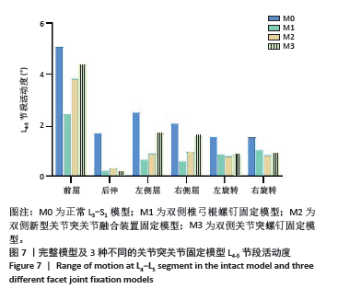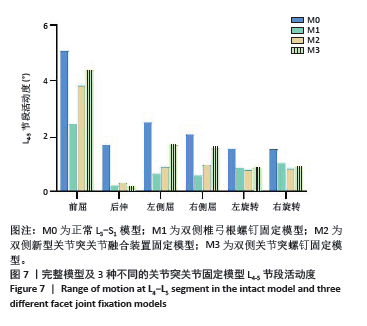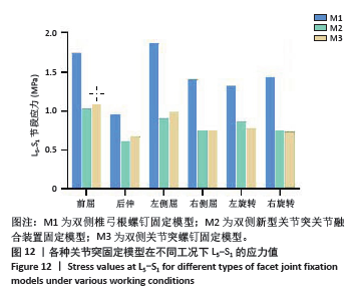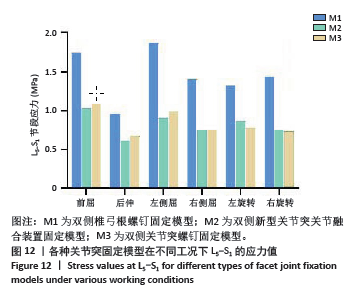Chinese Journal of Tissue Engineering Research ›› 2025, Vol. 29 ›› Issue (15): 3081-3088.doi: 10.12307/2025.176
Finite element analysis of a novel lumbar facet joint fusion device
Sun Feilong1, 2, Qiu Haiyang2, Ji Yufei2, Yang Yipeng2, Liu Daming2, Wang Longchao2, Wang Fei2, Lei Wei2, Zhang Yang2
- 1Graduate Student Department, Xi’an Medical University, Xi’an 710068, Shaanxi Province, China; 2Department of Orthopedics, Xijing Hospital, Air Force Medical University, Xi’an 710032, Shaanxi Province, China
-
Received:2024-03-01Accepted:2024-04-28Online:2025-05-28Published:2024-11-02 -
Contact:Zhang Yang, PhD, Master’s supervisor, Associate professor, Associate chief physician, Department of Orthopedics, Xijing Hospital, Air Force Medical University, Xi’an 710032, Shaanxi Province, China -
About author:Sun Feilong, Master candidate, Graduate Student Department, Xi’an Medical University, Xi’an 710068, Shaanxi Province, China; Department of Orthopedics, Xijing Hospital, Air Force Medical University, Xi’an 710032, Shaanxi Province, China -
Supported by:Key Research and Development Plan of Shaanxi Province, No. 2023-YBSF-146 (to ZY)
CLC Number:
Cite this article
Sun Feilong, Qiu Haiyang, Ji Yufei, Yang Yipeng, Liu Daming, Wang Longchao, Wang Fei, Lei Wei, Zhang Yang. Finite element analysis of a novel lumbar facet joint fusion device[J]. Chinese Journal of Tissue Engineering Research, 2025, 29(15): 3081-3088.
share this article
Add to citation manager EndNote|Reference Manager|ProCite|BibTeX|RefWorks
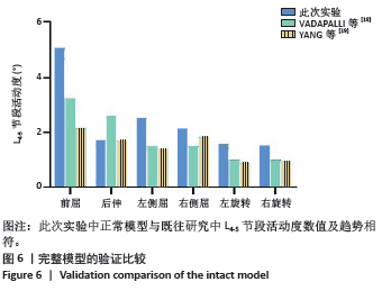
2.1 有限元模型的验证 整个L3-S1有限元模型由皮质骨、松质骨、髓核、纤维环和韧带等组成,相关材料见表1。在L3-S1完整模型的L3椎体上施加500 N的垂直向下力,同时加载7.5 Nm的扭矩,得到L4-5节段的前屈、后伸、左右侧屈、左右旋转的活动度,与VADAPALLI等[18]和YANG等[19]所测量的数据相近且变化趋势一致(图6),表明此次研究所建立模型可较好地模拟真实腰椎的运动情况,可以进一步用于分析腰椎在不同载荷下的生物力学变化。 2.2 各种模型L4-5节段活动度分析 图7显示各组模型在6个工况下L4-5节段的活动度。与完整模型相比,3组模型在各个工况下的活动度都有所下降;与双侧椎弓根螺钉固定相比,在前屈、后伸和左右侧屈4种工况下,双侧新型关节突关节固定装置在L4-5节段的活动度更大,分别增加了1.32°,0.11°,0.24°和0.39°;在左右旋转工况下略小,分别减少了0.72°和0.51°。与双侧关节突螺钉固定模型相比,除后伸外,其余工况下新型装置的活动度都更小。 "
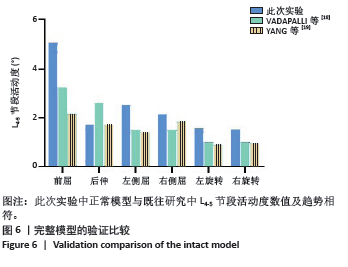
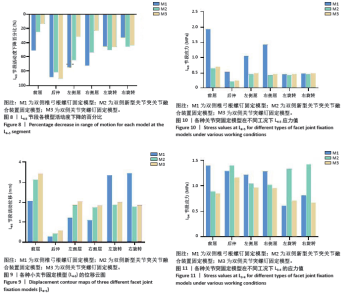
图8表示与完整模型相比各模型L4-5节段活动度下降的百分比。双侧椎弓根螺钉固定模型在前屈和左右侧屈工况下活动度下降最多,双侧新型装置固定模型在左右旋转工况下活动度下降最多,双侧关节突螺钉固定模型在后伸工况下活动度下降最多。 2.3 各种模型L4-5节段在6种工况下的位移分析 图9为各组模型在L4-5节段的位移云图。与双侧椎弓根螺钉相比,双侧新型装置固定在前屈、后伸和左右侧屈工况下在L4-5节段的位移更大,但其在左右旋转工况下的位移更小;与双侧关节突螺钉固定相比,双侧新型新型装置固定在6种工况下L4-5节段的位移都较小。 2.4 各种模型L4-5节段在6种工况下的应力分析 图10表示各组模型在L4-5节段的应力图。在前屈、后伸、左右侧屈和左右旋转6种工况下,双侧新型装置固定模型与其余两种模型相比其L4-5节段的应力都是最小的。 2.5 各种模型邻近节段(L3-4、L5-S1)在6种工况下的应力分析 图11,12分别表示3种关节突关节固定模型在L3-4节段和L5-S1节段的应力分析。如图11所示,在后伸和左右旋转工况下,新型装置固定模型在L3-4节段的应力比其余两种固定模型的应力大;在前屈和左右侧屈工况下,双侧新型装置固定模型在L3-4节段的应力小于双侧椎弓根螺钉固定模型,且大于双侧关节突螺钉固定模型。如图12所示,在前屈、后伸和左侧屈工况下双侧新型装置固定与其余两种模型相比在L5-S1节段的应力值是最小的;在右侧屈和左右旋转工况下,双侧新型装置固定在L5-S1节段的应力值都是明显小于双侧椎弓根螺钉固定,且略大于双侧关节突螺钉固定模型。"
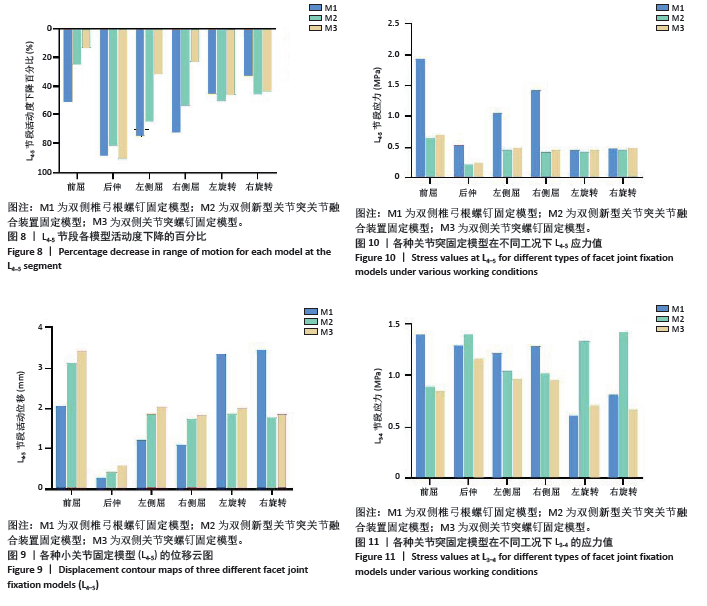
| [1] SEIDEL MF, NETZER C, CHOBAZ V, et al. Localization of Nerve Growth Factor Expression to Structurally Damaged Cartilaginous Tissues in Human Lumbar Facet Joint Osteoarthritis. Front Immunol. 2022;13: 783076. [2] TIWARI P, KAUR H, JHA V, et al. Chronology of disc degeneration and facet joint arthritis in lumbar spine is variable - A CT based cross-sectional study. J Orthop Sci. 2022;27(6):1197-1202. [3] KATZ JN, ZIMMERMAN ZE, MASS H, et al. Diagnosis and Management of Lumbar Spinal Stenosis: A Review. JAMA. 2022;327(17):1688-1699. [4] GODOLIAS P, FRIELER S, TATARYN ZL, et al. Towards a More Realistic Appraisal of Complications Following Staged Lateral Lumbar Interbody Fusion: A Single Institution Series. Global Spine J. 2024;14(1): 130-137. [5] TAO X, MATUR AV, KHALID S, et al. TLIF is Associated With Lower Rates of Adjacent Segment Disease and Complications Compared to ALIF: A Matched-Cohort Analysis. Spine. 2023;48(19):1335-1341. [6] ARAGHI K, FOURMAN MS, MERRILL RK, et al. Postoperative Radiculitis After L5-S1 Anterior Lumbar Interbody Fusion. Spine. 2023;48(18): 1317-1325. [7] SUN D, LIANG W, HAI Y, et al. OLIF versus ALIF: Which is the better surgical approach for degenerative lumbar disease? A systematic review. Eur Spine J. 2023;32(2):689-699. [8] EMAMI A, PATEL N, COBAN D, et al. Comparing clinical and radiological outcomes between single-level OLIF and XLIF: A systematic review and meta-analysis. N Am Spine Soc J. 2023;14:100216. [9] WELCH-PHILLIPS A, GIBBONS D, AHERN DP, et al. What Is Finite Element Analysis? Clin Spine Surg. 2020;33(8):323-324. [10] SIMON L, MILLOT F, HOARAU X, et al. Comparison of the Biomechanical Effect of the FFX Device Compared With Other Lumbar Fusion Devices: A Finite Element Study. Int J Spine Surg. 2022;16(5):935-943. [11] CAI XY, SUN MS, HUANG YP, et al. Biomechanical Effect of L4 -L5 Intervertebral Disc Degeneration on the Lower Lumbar Spine: A Finite Element Study. Orthop Surg. 2020;12(3):917-930. [12] FAN W, GUO LX. Influence of different frequencies of axial cyclic loading on time-domain vibration response of the lumbar spine: A finite element study. Comput Biol Med. 2017:86:75-81. [13] CHOI HW, KIM YE. Effect of lumbar fasciae on the stability of the lower lumbar spine. Comput Methods Biomech Biomed Engin. 2017; 20(13):1431-1437. [14] SRINIVAS GR, KUMAR MN, DEB A. Adjacent Disc Stress Following Floating Lumbar Spine Fusion: A Finite Element Study. Asian Spine J. 2017;11(4):538-547. [15] KALICHMAN L, LI L, KIM DH, et al. Facet Joint Osteoarthritis and Low Back Pain in the Community-Based Population. Spine. 2008;33(23): 2560-2565. [16] DREISCHARF M, ZANDER T, SHIRAZI-ADL A, et al. Comparison of eight published static finite element models of the intact lumbar spine: Predictive power of models improves when combined together. J Biomech. 2014;47(8):1757-1766. [17] ROHLMANN A, ZANDER T, RAO M, et al. Realistic loading conditions for upper body bending. J Biomechan. 2009;42(7): 884-890. [18] VADAPALLI S, SAIRYO K, GOEL VK, et al. Biomechanical rationale for using polyetheretherketone (PEEK) spacers for lumbar interbody fusion-A finite element study. Spine. 2006;31(26):E992-E998. [19] YANG M, SUN G, GUO S, et al. The Biomechanical Study of Extraforaminal Lumbar Interbody Fusion: A Three-Dimensional Finite-Element Analysis. J Healthc Eng. 2017:2017:9365068. [20] SONG M, SUN K, LI Z, et al. Stress distribution of different lumbar posterior pedicle screw insertion techniques: a combination study of finite element analysis and biomechanical test. Sci Rep. 2021;11: 12968. [21] EASTLACK RK, NUNLEY PD, POELSTRA KA, et al. Finite element analysis comparing a PEEK posterior fixation device versus pedicle screws for lumbar fusion. J Orthop Surg Res. 2023;18(1):855. [22] PAN CC, LEE CH, CHEN KH, et al. Comparative Biomechanical Analysis of Unilateral, Bilateral, and Lateral Pedicle Screw Implantation in Oblique Lumbar Interbody Fusion: A Finite Element Study. Bioengineering (Basel, Switzerland). 2023;10(11):1238. [23] GOEL A, SHAH A, JADHAV M, et al. Distraction of facets with intraarticular spacers as treatment for lumbar canal stenosis: report on a preliminary experience with 21 cases: Clinical article. J Neurosurg Spine. 2013;19(6):672-677. [24] GOEL A. Facet distraction spacers for treatment of degenerative disease of the spine: Rationale and an alternative hypothesis of spinal degeneration. J Craniovertebr Junction Spine. 2010;1(2):65-66. [25] GOEL A, MEHTA P, SATOSKAR S, et al. Quantitative morphometric analysis of the lumbar vertebral facets and evaluation of feasibility of lumbar spinal nerve root and spinal canal decompression using the Goel intraarticular facetal spacer distraction technique: A lumbar/cervical facet comparison. J Craniovertebr Junction Spine. 2014;5(4):157-162. [26] SROUR R, GDOURA Y, DELAITRE M, et al. Facet Arthrodesis with the FFX Device: One-Year Results from a Prospective Multicenter Study. Int J Spine Surg. 2020;14(6):996-1002. [27] SROUR R. Comparison of Operative Time and Blood Loss With the FFX® Device Versus Pedicle Screw Fixation During Surgery for Lumbar Spinal Stenosis: A Retrospective Cohort Study. Cureus. 2022;14(3):e22931. [28] ZHANG X, WANG Y, ZHANG W, et al. Perioperative Clinical Features and Long-term Prognosis After Oblique Lateral Interbody Fusion (OLIF), OLIF With Anterolateral Screw Fixation, or OLIF With Percutaneous Pedicle Fixation: A Comprehensive Treatment Strategy for Patients With Lumbar Degenerative Disease. Neurospine. 2023;20(2):536-549. [29] HE W, HE D, SUN Y, et al. Standalone oblique lateral interbody fusion vs. combined with percutaneous pedicle screw in spondylolisthesis. BMC Musculoskelet Disord. 2020;21(1):184. [30] KAPETANAKIS S, GKANTSINIKOUDIS N. Anatomy of lumbar facet joint: a comprehensive review. Folia Morphologica. 2021;80(4):799-805. [31] YANG KH, KING AI. Mechanism of facet load transmission as a hypothesis for low-back pain. Spine. 1984;9(6):557-565. [32] ADAMS MA, HUTTON WC. The effect of posture on the role of the apophysial joints in resisting intervertebral compressive forces. J Bone Joint Surg Br. 1980;62(3):358-362. [33] OLDWEILER AB, MARTIN JT. In vivo relationships between lumbar facet joint and intervertebral disc composition and diurnal deformation. Clin Biomech (Bristol, Avon). 2021:88:105425. [34] PRADO M, MASCOLI C, GIAMBINI H. Discectomy decreases facet joint distance and increases the instability of the spine: A finite element study. Comput Biol Med. 2022;143:105278. [35] FINE N, LIVELY S, SÉGUIN CA, et al. Intervertebral disc degeneration and osteoarthritis: a common molecular disease spectrum. Nature Reviews. Rheumatology. 2023;19(3):136-152. [36] BUTLER D, TRAFIMOW JH, ANDERSSON GB, et al. Discs degenerate before facets. Spine. 1990;15(2):111-113. [37] XIA XP, CHEN HL, CHENG HB. Prevalence of Adjacent Segment Degeneration After Spine Surgery: A Systematic Review and Meta-analysis. Spine. 2013;38(7):597. [38] TAKEDA K, OKADA E, SHINOZAKI Y, et al. Risk factors for early-onset radiographical adjacent segment disease in patients with spondylolytic spondylolisthesis after single-level posterior lumbar interbody fusion. Spine J. 2022;22(7):1112-1118. [39] YUAN C, ZHOU J, WANG L, et al. Adjacent segment disease after minimally invasive transforaminal lumbar interbody fusion for degenerative lumbar diseases: incidence and risk factors. BMC Musculoskelet Disord. 2022;23(1):982. [40] WEINHOFFER SL, GUYER RD, HERBERT M, et al. Intradiscal pressure measurements above an instrumented fusion. A cadaveric study. Spine. 1995;20(5):526-531. [41] CUNNINGHAM BW, KOTANI Y, MCNULTY PS, et al. The effect of spinal destabilization and instrumentation on lumbar intradiscal pressure: an in vitro biomechanical analysis. Spine. 1997;22(22):2655-2663. |
| [1] | Xu Hao, Ding Lu, Li Xiao. Investigating the effect of the mechanical wear on abutment screw in Morse taper connection implant implant system by using finite element analysis [J]. Chinese Journal of Tissue Engineering Research, 2025, 29(在线): 1-9. |
| [2] | Li Liangkui, Huang Yongcan, Wang Peng, Yu Binsheng. Effect of anterior controllable anteriodisplacement and fusion on vertebrae-ossification of posterior longitudinal ligament complex and implants: a finite element analysis [J]. Chinese Journal of Tissue Engineering Research, 2025, 29(9): 1761-1767. |
| [3] | Xu Biao, Lu Tan, Jiang Yaqiong, Yin Yujiao. Xu Biao, Lu Tan, Jiang Yaqiong, Yin Yujiao [J]. Chinese Journal of Tissue Engineering Research, 2025, 29(9): 1768-1774. |
| [4] | Zhou Jinhai, Li Jiangwei, Wang Xuquan, Zhuang Ying, Zhao Ying, Yang Yuyong, Wang Jiajia, Yang Yang, Zhou Shilian. Three-dimensional finite element analysis of anterior femoral notching during total knee arthroplasty at different bone strengths [J]. Chinese Journal of Tissue Engineering Research, 2025, 29(9): 1775-1782. |
| [5] | Chen Xi, Tang Tao, Chen Tongbing, Li Qing, Zhang Wen. Mechanical stability of intertrochanteric fracture of femur with different internal fixation systems [J]. Chinese Journal of Tissue Engineering Research, 2025, 29(9): 1783-1788. |
| [6] | Fu Enhong, Yang Hang, Liang Cheng, Zhang Xiaogang, Zhang Yali, Jin Zhongmin. OpenSim-based prediction of lower-limb biomechanical behavior in adolescents with plantarflexor weakness [J]. Chinese Journal of Tissue Engineering Research, 2025, 29(9): 1789-1795. |
| [7] | Miao Jiahang, Ma Sheng, Li Qupeng, Yu Huilin, Hu Tianyu, Gao Xiao, Feng Hu. Cervical lordosis ratio can be used as a decision-making indicator for selection of posterior surgical approach for multi-level cervical spondylotic myelopathy [J]. Chinese Journal of Tissue Engineering Research, 2025, 29(9): 1796-1802. |
| [8] | Huang Haobo, Liang Xinyuan, Ye Guozhong, Xie Qingxiang, Su Boyuan. Suture tape and headless compression screws in treatment of Lisfranc injury with comminuted fractures of the first and second proximal metatarsal bones [J]. Chinese Journal of Tissue Engineering Research, 2025, 29(9): 1803-1809. |
| [9] | Zhang Hao, Wang Qing, Zhang Jian, Li Guangzhou, Wang Gaoju. Comparison of posterior C2-3 fixation combined with bucking bar technique and posterior C2-3 fixation alone in treatment of unstable Hangman fractures [J]. Chinese Journal of Tissue Engineering Research, 2025, 29(9): 1848-1854. |
| [10] | Su Lintao, Jiang Jianfeng, Ma Jun, Huang Liangliang, Lei Changyu, Han Yaozheng, Kang Hui. Precise application of O-arm navigation system in thoracolumbar fractures with developmental pedicle stenosis [J]. Chinese Journal of Tissue Engineering Research, 2025, 29(9): 1855-1862. |
| [11] | Gao Zhenyang, Zeng Xiuan, Yang Qibing, Kou Xianshuai, Wang Kejing, Li Meng. Computer-simulated repositioning combined with pelvic reduction frame for treatment of anteroposterior compression-III pelvic fractures [J]. Chinese Journal of Tissue Engineering Research, 2025, 29(9): 1870-1875. |
| [12] | Zhou Jiajun, Ma Fei, Leng Yebo, Xu Shicai, He Baoqiang, Li Yang, Liao Yehui, Tang Qiang, Tang Chao, Wang Qing, Zhong Dejun. Assessing distribution characteristics and clinical significance of vertebral fractures in patients with osteoporosis based on whole spine MRI [J]. Chinese Journal of Tissue Engineering Research, 2025, 29(9): 1883-1889. |
| [13] | Sun Xiaojun, Wang Huaming, Zhang Dehong, Song Xuewen, Huang Jin, Zhang Chen, Pei Shengtai. Effect of finite element method in treatment of developmental dysplasia of the hip in children [J]. Chinese Journal of Tissue Engineering Research, 2025, 29(9): 1897-1904. |
| [14] | Lou Guo, Zhang Min, Fu Changxi. Exercise preconditioning for eight weeks enhances therapeutic effect of adipose-derived stem cells in rats with myocardial infarction [J]. Chinese Journal of Tissue Engineering Research, 2025, 29(7): 1363-1370. |
| [15] | Lu Jieming, Li Yajing, Du Peijie, Xu Dongqing. Effects of artificial turf versus natural grass on biomechanical performance of the lower limbs in young females during jump-landing [J]. Chinese Journal of Tissue Engineering Research, 2025, 29(6): 1101-1107. |
| Viewed | ||||||
|
Full text |
|
|||||
|
Abstract |
|
|||||
